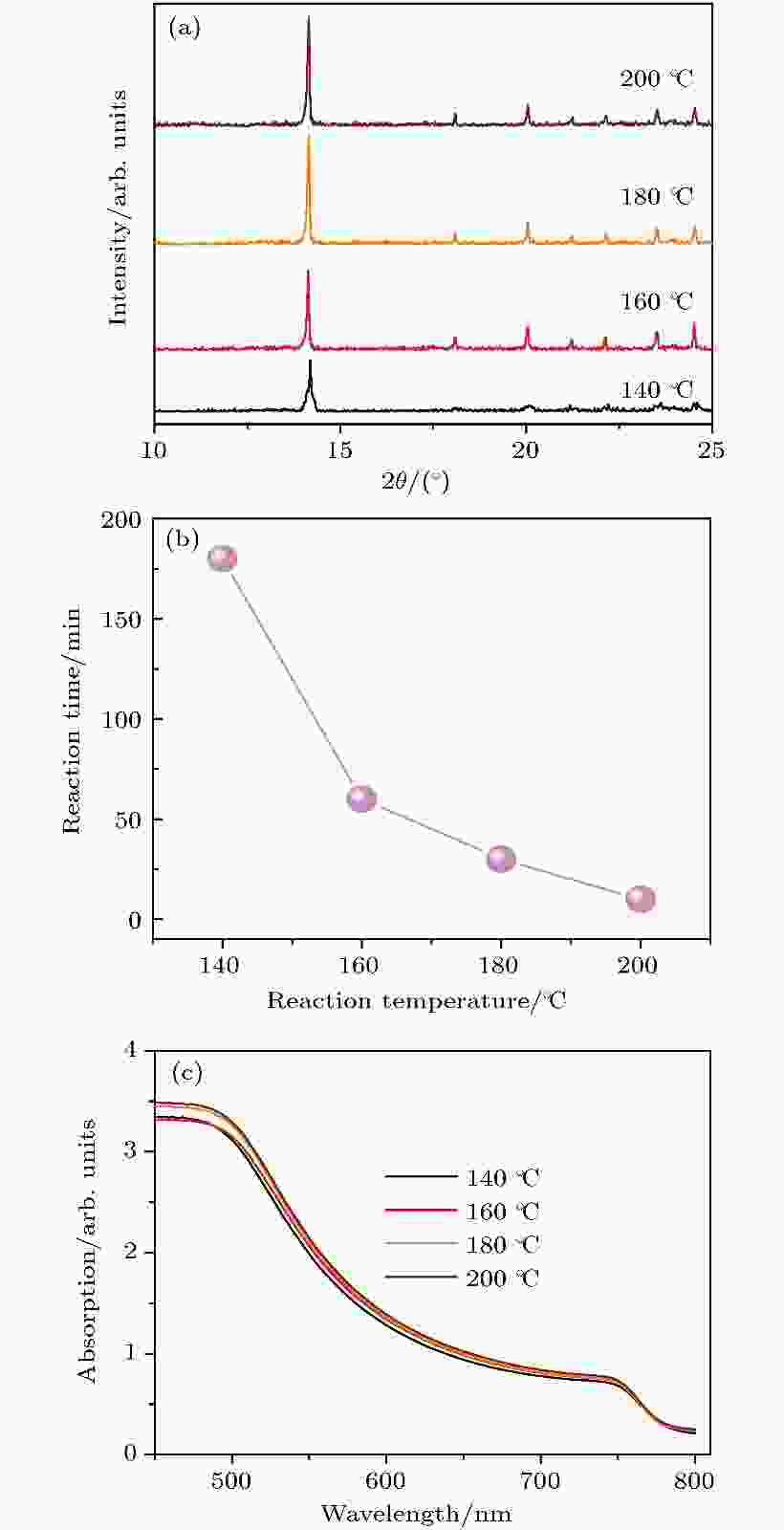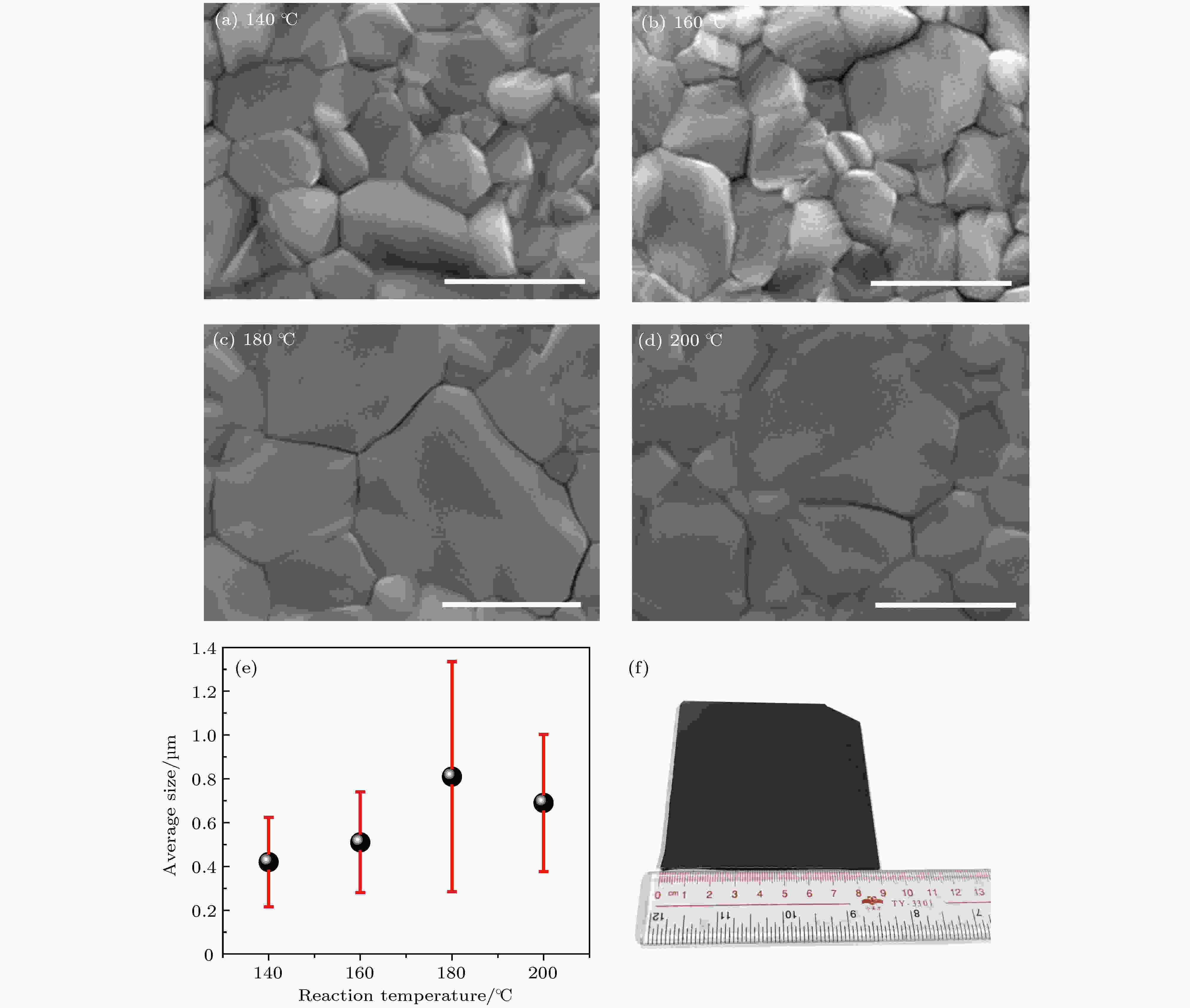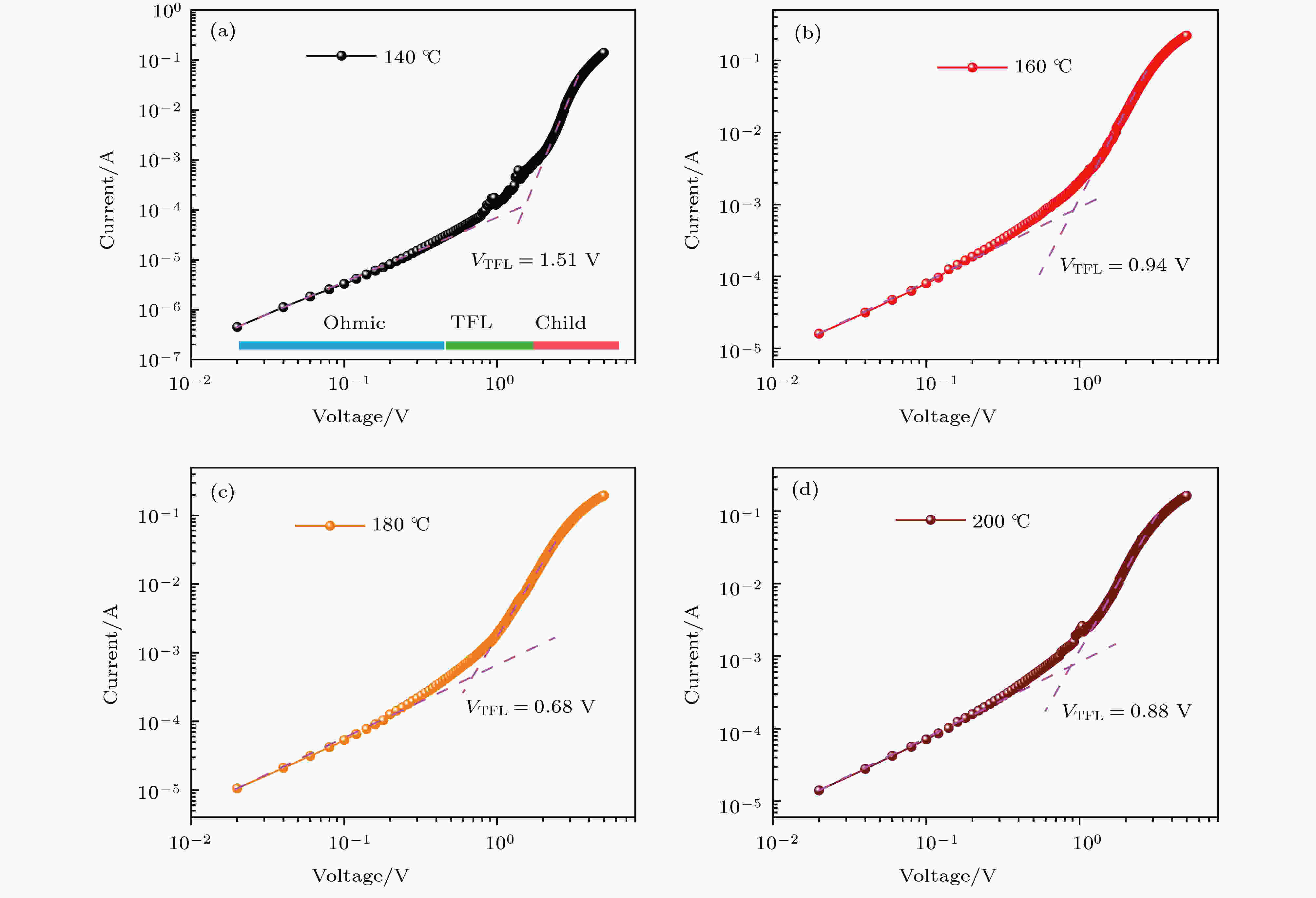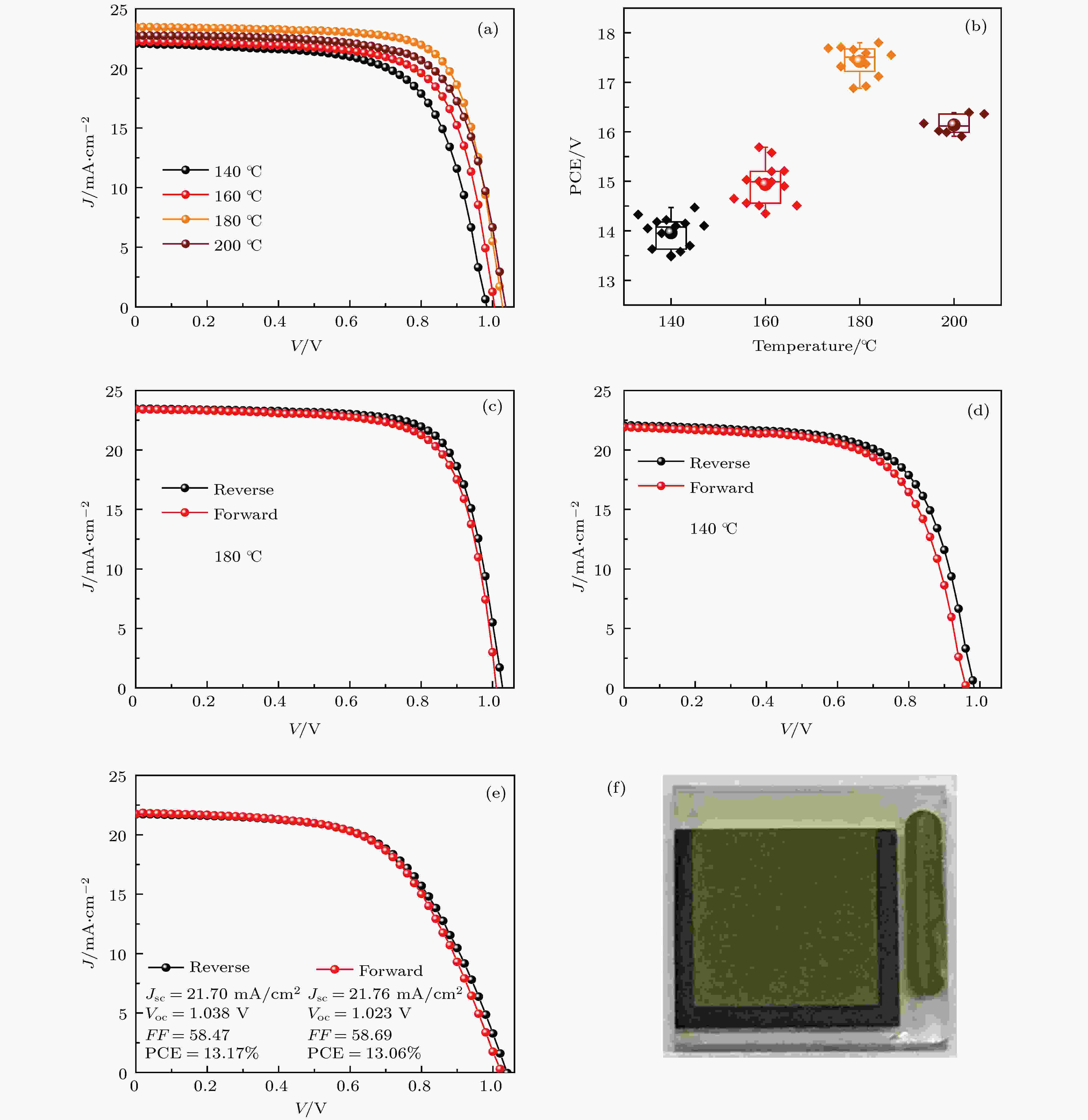全文HTML
--> --> -->目前基于PSCs的制备可以分为溶液法、气相法以及两者结合的气相辅助溶液法. 气相法制备半导体薄膜是一种成熟的工业工艺技术, 还能够免除有毒溶剂的使用, 气相法制备PSCs是实现PSCs产业化的一种可选的绿色制备方法. 2013年, Snaith课题组[9]最先运用气相法通过有机源、无机源共蒸及后退火过程制备出相比溶液法更致密的钙钛矿薄膜, 获得了15.4%的PCE[10]. 2016年, Lin等[11]通过两步气相沉积和控制反应过程的压强制备出全气相法器件(包括电子传输层和空穴传输层), PCE高达17.6%. 2017年, 该课题组同样制备了全气相的无机钙钛矿器件, 并获得超过11%的PCE[12]. Cs+/FA+体系由于其优越的稳定性而被认为是最有潜力的一种钙钛矿材料组合[13]. 2018年, Chen课题组[14]通过先于TiO2衬底上分别蒸镀CsBr和PbBr2之后再用化学气相沉积使CsBr/PbBr2薄膜与FAI气体反应构建一种具有能带梯度的Cs0.15FA0.85PbI2.85Br0.15薄膜, 基于FTO/TiO2/ Cs0.15FA0.85PbI2.85Br0.15/spiro-OMeTAD/Ag结构的PCE达到18.2%. 直到目前为止, 气相法制备PSCs的最高PCE为20.1%[15].
虽然气相法制备的钙钛矿薄膜更均匀致密, 但是许多气相法的工作也仅仅是改变钙钛矿层的组分, 缺少一些有效的晶体调控手段. 而溶液法中可以通过添加NH4+, I–, SCN–等[16-20]离子的手段来精细调控钙钛矿薄膜的结晶过程以及钝化钙钛矿薄膜的缺陷从而提高PSCs的性能, 这是到目前为止气相法制备的器件PCE低于溶液法的重要原因之一. 为此, 我们利用两步气相反应, 通过控制有机碘甲胺(MAI)与无机碘化铅(PbI2)的反应温度实现了气相法中钙钛矿薄膜的晶粒大小的调控. 在140 ℃的气相反应中, 制备的MAPbI3 薄膜的平均粒径是0.42









2.1.材料准备
TiO2前驱液的准备过程为: 将369



本实验中合成钙钛矿的原材料材料为MAI(CH3NH3I, 日本TCI公司, 纯度 > 98%)和PbI2(PbI2, 美国Sigma-Aldrich公司, 纯度99%). 空穴传输材料前驱液为80 mg的spiro-OMeTAD(优选科技有限公司, 纯度99 %)溶解在1 mL的氯苯(美国Sigma-Aldrich公司, 纯度99.8%)中, 并掺杂了17.5




2
2.2.器件制备
将刻蚀好的FTO(NSG-15)衬底用洗涤剂、去离子水、丙酮、异丙醇依次超声清洗30 min, N2气枪吹干后, O2 plasma处理(95 W) 5 min. 将提前配备好的TiO2前驱液以5000 r/min, 旋涂30 s, 500 ℃下退火30 min. 待温度降至100 ℃以下后, 取出TiO2衬底放进热蒸发镀膜机中, 在5 × 10–4 Pa下依次蒸镀5 nm的C60和150 nm的PbI2. 将蒸镀好PbI2薄膜的衬底取出后, 倒扣在放有100 mg MAI粉末的石英方舟上, 置于温度分别为140 ℃, 160 ℃, 180 ℃, 200 ℃的真空烘箱中, 蒸发MAI, 让MAI与PbI2反应生成MAPbI3钙钛矿薄膜, 反应时间分别为180, 60, 30和10 min. 反应完成后, 将样品移到手套箱, 待充分冷却后用异丙醇清洗样品除去可能存在于表面的多余的MAI并于加热台上进行100 ℃, 10 min退火. 冷却后旋涂spiro-OMeTAD溶液, 并放置在干燥箱中氧化21 h[21]. 在5 × 10–4 Pa下热蒸镀80 nm的金电极, 完成PSCs器件制备.2
2.3.测 试
器件的J-V特性曲线在AM 1.5 G, 标准电池校准光强为100 mW/cm2的光源下使用Keithley 2400 数字源表(SourceMeter)系列测试仪测得, 测试环境为室温氮气氛围. 扫描电子显微镜(SEM)图片由德国ZEISS公司型号为Ultra 55的扫描电子显微镜测得. X射线衍射(XRD)采用德国BRUKER D8 ADVANCE. U-V吸收光谱采用岛津仪器SHIMADZU UV-2600测得. 光致发光(PL)光谱采用Horiba, LabRAM HR Evolution Inc配备532 nm探测激光测得. 空间电荷限制电流(space charge limited current, SCLC)模型的测试结构为FTO/TiO2/CH3NH3PbI3/PCBM/Au用Keithley 2400 SourceMeter在暗态条件下测试.3.1.两步气相法制备MAPbI3钙钛矿薄膜及晶粒的调控
如图1(a)所示, 我们通过两步气相反应来完成钙钛矿薄膜的制备. 首先通过真空物理沉积法在TiO2衬底上蒸镀厚度为150 nm的PbI2薄膜. 考虑到MAI分子蒸发的弥散性, 我们采用近距离扩散的方法来完成PbI2与MAI的反应. 将蒸镀好的PbI2薄膜倒扣在装有100 mg MAI粉末的石英方舟上方, 源与衬底的距离仅为2 cm. 之后将石英方舟放进预先设置好温度的真空烘箱中进行反应. 在反应过程中, 气化的MAI气体分子扩散到PbI2薄膜内部, 使得“面共享”的八面体结构转化成“点共享”的八面体结构, 同时MA分子嵌入晶格框架形成钙钛矿结构(图1(b)). 图 1 钙钛矿薄膜的气相制备流程及效果 (a)两步钙钛矿薄膜气相制备流程示意图; (b)PbI2与MAI气体反应示意图; (c)器件SEM截面图
图 1 钙钛矿薄膜的气相制备流程及效果 (a)两步钙钛矿薄膜气相制备流程示意图; (b)PbI2与MAI气体反应示意图; (c)器件SEM截面图Figure1. Vapor growth of perovskite film: (a) Schematic growth processes of two-step vapor growth of perovskite films; (b) reaction schematic between the PbI2 structure and the MAI molecule; (c) the cross-sectional morphology of the as-prepared device.
为了探究最佳的PbI2与MAI反应的温度, 我们设计了140 ℃, 160 ℃, 180 ℃以及200 ℃共4组反应温度. 首先, 对不同反应温度下制备的MAPbI3薄膜结构进行确认. 如图2(a)所示, 反应生成的薄膜在14.1°, 20.0°, 23.4°, 24.5°, 分别出现MAPbI3(110)面、(112)面、(221)面、(202)面的特征峰, 证明生成的薄膜为MAPbI3薄膜[22]. 在12.6°处没有发现PbI2(001)面的特征峰, 基本确定薄膜中不存在PbI2的残留, 说明PbI2已经完全转化为MAPbI3. 进一步分析图2(a)的XRD谱图, 发现随着制备温度的提高, MAPbI3(110)面的峰值强度迅速增加, 在180 ℃达到峰值, 温度继续提高有略微的下降. 与此同时, XRD的半峰宽随着温度提高也明显减少, 这意味着较高反应温度下薄膜得到了更好的结晶. 实验发现(图2(b)), 完全转化所需的时间随着反应温度的升高而减小, 140 ℃下所需要的时间长达180 min, 而当温度达到200 ℃时, 所需时间降低为10 min. 更高的反应温度存在着更快的合成过程与更快的分解过程. 在200 ℃反应温度的条件下平均粒径减少, 可能是由于此温度下存在较大的MAPbI3分解现象, 导致晶粒减小. 图2(c)的紫外-可见吸收光谱(UV-vis)显示, 不同条件下制备的薄膜都有趋近780 nm的吸收边, 对应着MAPbI3的禁带宽度(Eg) 1.58 eV. 在可见光范围内, 可以发现180 ℃以及200 ℃制备的薄膜都有较高的吸收度. 相比之下, 140 ℃条件下制备的钙钛矿薄膜明显低于180 ℃制备的薄膜.
 图 2 不同反应温度下钙钛矿薄膜的表征 (a)薄膜的XRD图谱; (b)不同反应温度下PbI2向MAPbI3完全转化所需的时间; (c)薄膜的吸收图谱
图 2 不同反应温度下钙钛矿薄膜的表征 (a)薄膜的XRD图谱; (b)不同反应温度下PbI2向MAPbI3完全转化所需的时间; (c)薄膜的吸收图谱Figure2. (a) The XRD patterns; (b) reaction time for fully conversion of PbI2 to MAPbI3 under different reaction temperature; (c) UV-vis spectra of perovskite films synthesized under different temperature.
进一步利用SEM研究了MAPbI3薄膜形态. 图3(a)—(d)显示不同的反应温度下, 薄膜均致密均匀. 当MAI的蒸发温度为140 ℃时, 构成薄膜的MAPbI3平均粒径约为0.42




































 图 3 温度对钙钛矿薄膜形态的影响 (a)—(d)反应温度分别为140 ℃, 160 ℃, 180 ℃以及200 ℃时制备的钙钛矿的SEM形貌图(白色线段长度为1
图 3 温度对钙钛矿薄膜形态的影响 (a)—(d)反应温度分别为140 ℃, 160 ℃, 180 ℃以及200 ℃时制备的钙钛矿的SEM形貌图(白色线段长度为1 
Figure3. Reaction temperature effect on the morphology of perovskite film: (a)–(d) SEM images of perovskite films with reaction temperature of (a) 140 ℃, (b) 160 ℃, (c) 180 ℃ and (d) 200 ℃ (the scale bars in the SEM images are 1

2
3.2.钙钛矿薄膜缺陷测试
在PSCs中, 调控晶粒的大小往往能够减少薄膜的缺陷, 从而使得载流子的传输更加有效[23]. 为确定薄膜的缺陷密度, 我们设计了基于电子传输层的FTO/TiO2/MAPbI3/PCBM/Au器件结构, 测试了器件的暗态I-V曲线. 利用SCLC来分析缺陷密度[24]. 钙钛矿层的缺陷会捕获载流子, 从而降低自由载流子的浓度. 在较低的测试偏压下, 电流和电压呈线性关系. 当测试电压逐渐增大时, 注入的载流子不断被缺陷所捕获. 当缺陷完全被填充时, 电流会出现非线性增加, 即I-V曲线上出现转折点, 这个点对应的电压就是缺陷填充电压(VTFL), 可由线性增长部分的切线与非线性增长部分的切线交点获得. 如图4(a)—(d)分别代表不同反应温度下的暗态I-V曲线. 在较低偏压下电流I ∝ V为欧姆区域(Ohmic, 蓝色区域), 中间电压部分I ∝ Vn(n > 3)为缺陷填充区(trap-filled limited, 绿色区域), 高偏压部分I ∝ V2为SCLC区域(红色区域). 根据(1)式[19]: 图 4 钙钛矿薄膜的缺陷密度测试 (a) 140 ℃; (b) 160 ℃; (c) 180 ℃; (d) 200 ℃
图 4 钙钛矿薄膜的缺陷密度测试 (a) 140 ℃; (b) 160 ℃; (c) 180 ℃; (d) 200 ℃Figure4. Trap density measurement in perovskite synthesized under different temperature: (a) 140 ℃; (b) 160 ℃; (c) 180 ℃ and (d) 200 ℃.


2
3.3.光伏器件的性能
采用FTO/TiO2/C60/MAPbI3/spiro-OMeTAD/ Au结构, 其中TiO2厚度约为50 nm, MAPbI3厚度约为530 nm (图1(c)), spiro-OMeTAD厚度约为140 nm, 基于上述钙钛矿薄膜制备了面积为0.045 cm2的光伏器件. 图5(a)展示了不同反应温度下对应的器件J-V曲线, 可以看到器件的性能与晶粒尺寸相关. 表格1给出了具体的器件参数. 当反应温度为140 ℃时, 器件的短路电流密度(Jsc)为22.04 mA/cm2, 开路电压(Voc)为0.99 V, 填充因子(FF)为66.31%, 对应的PCE为14.47%. 当反应温度为180 ℃时, Jsc提升到23.47 mA/cm2, Voc达到1.02 V, FF增加到74.35%, 最终器件转换效率达到最佳的17.80%. 图5(b)给出了多组器件的统计数据, 可见器件的性能与晶体粒径相关. 具体的参数列于表1. 140 ℃, 160 ℃, 180 ℃和200 ℃对应的统计平均值PCE为14.00%, 14.93%, 17.42%和16.13%. 另一方面, 随着粒径的增加, 器件的迟滞现象也明显减小. 在180 ℃下制备的器件, 反向扫描的PCE为17.80%, 正向扫描的PCE为17.08%, 由迟滞因子的计算公式[25] 图 5 钙钛矿光伏器件性能 (a)标准光照下面积为0.045 cm2器件的J-V曲线; (b)多组器件效率的统计结果; (c)面积为0.045 cm2器件180 ℃下制备的器件回滞曲线; (d)面积为0.045 cm2器件140 ℃下制备的器件回滞曲线; (e)面积为1 cm2 器件180 ℃下制备的器件J-V曲线; (f) 1 cm2 器件的光学图片
图 5 钙钛矿光伏器件性能 (a)标准光照下面积为0.045 cm2器件的J-V曲线; (b)多组器件效率的统计结果; (c)面积为0.045 cm2器件180 ℃下制备的器件回滞曲线; (d)面积为0.045 cm2器件140 ℃下制备的器件回滞曲线; (e)面积为1 cm2 器件180 ℃下制备的器件J-V曲线; (f) 1 cm2 器件的光学图片Figure5. Device performance of perovskite photovoltaic devices: (a) 0.045 cm2 device reverse J-V curves under 1 Sun AM 1.5 G; (b) statistical distribution of PCE; reverse and forward J-V curves of devices (0.045 cm2) grown at (c) 180 ℃ and (d) 140 ℃; (e) reverse and forward J-V curves of device (1 cm2) grown at 180 ℃ and (f) corresponding optical image.
| Sythesis temperature | Jsc/mA·cm-2 | Voc/V | FF/% | Champion PCE/% | Average PCE/% |
| 140 | 22.04 | 0.99 | 66.31 | 14.47 | 14.00 |
| 160 | 22.25 | 1 | 70.51 | 15.69 | 14.93 |
| 180 | 23.47 | 1.02 | 74.35 | 17.80 | 17.42 |
| 200 | 22.75 | 1.03 | 70.88 | 16.61 | 16.13 |
表1不同反应温度的器件具体性能参数以及统计值
Table1.Characteristic parameters and statistical result of PSCs.











